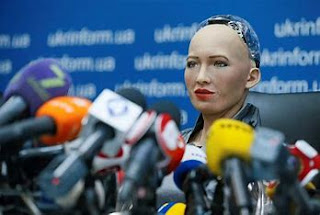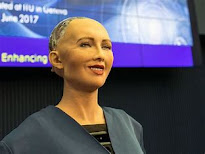Sofia the robot
- Get link
- X
- Other Apps
Sofia the Robot: A Comprehensive Exploration

In the realm of artificial intelligence and robotics, Sofia stands as a remarkable and widely recognized figure. Developed by Hanson Robotics, Sofia represents a fusion of cutting-edge technology and human-like aesthetics, pushing the boundaries of what we perceive as possible in the realm of robotics. This exploration delves into the origins, technological intricacies, capabilities, societal impact, and future
prospects of Sofia the Robot.
Origins and Development
Sofia's journey begins with Hanson Robotics, a Hong Kong-based company founded by Dr. David Hanson. The company's mission revolves around creating robots with human-like appearance and behavior, aiming to bridge the gap between humans and machines. Sofia, introduced to the world in 2016, quickly captured global attention with her strikingly lifelike features and advanced conversational abilities.
At the core of Sofia's development lies a sophisticated combination of robotics, artificial intelligence, and material science. Her facial expressions, for instance, are achieved through a combination of patented Frubber material and a network of sensors, allowing her to mimic human expressions with remarkable accuracy. Moreover, her conversational capabilities are powered by a blend of natural language processing algorithms and machine learning techniques, enabling her to engage in meaningful interactions with humans.
Technological Intricacies
Sofia's design and functionality are a testament to the advancements made in various fields of science and engineering. Let's delve into some of the key technological intricacies that enable Sofia to operate:
Facial Recognition and Expression: Sofia's face is equipped with cameras and sensors that allow her to recognize faces and interpret emotions. Her Frubber material, designed to mimic human skin, enables her to produce a wide range of facial expressions, conveying emotions such as happiness, sadness, surprise, and more.
Natural Language Processing (NLP): Sofia's ability to understand and generate human-like speech relies on sophisticated NLP algorithms. These algorithms enable her to process language inputs, extract meaning, and generate appropriate responses in real-time.
Machine Learning: Sofia's conversational abilities are continuously refined through machine learning algorithms. By analyzing vast amounts of data, she can adapt her responses based on context and user feedback, gradually improving the quality of her interactions over time.
Sensor Integration: Sofia is equipped with various sensors, including cameras, microphones, and touch sensors, which enable her to perceive and interact with her environment. These sensors provide her with valuable input data, allowing her to navigate physical spaces and respond to stimuli effectively.
Capabilities and Applications
Sofia's capabilities extend beyond mere conversation, encompassing a wide range of functionalities and potential applications:
Companion and Assistant: Sofia can serve as a companion or assistant in various settings, providing companionship to the elderly or individuals with special needs, assisting with daily tasks, and offering information and entertainment.
Education and Entertainment: Sofia can be utilized as an educational tool, helping students learn about robotics, artificial intelligence, and other STEM subjects in an engaging and interactive manner. Additionally, she can entertain audiences through performances and demonstrations.
Customer Service: Sofia can be deployed in customer service roles, providing assistance and information to customers in retail stores, airports, hotels, and other public spaces. Her ability to understand natural language and respond intelligently makes her well-suited for such applications.
Research and Development: Sofia serves as a platform for research and development in the fields of robotics, artificial intelligence, and human-robot interaction. Researchers can study her behavior and interactions to gain insights into human cognition and emotions, as well as to advance the state-of-the-art in robotics technology.
Societal Impact and Ethical Considerations
The introduction of humanoid robots like Sofia raises important societal and ethical considerations that warrant careful examination:
Impact on Employment: The widespread adoption of robots like Sofia in various industries could potentially lead to job displacement, particularly in sectors where human labor is replaced by automation. It is essential to consider strategies for reskilling and retraining the workforce to adapt to the changing technological landscape.
Privacy and Data Security: As robots become more integrated into our daily lives, concerns regarding privacy and data security emerge. Sofia's ability to perceive and process information raises questions about data collection, storage, and usage, necessitating robust privacy safeguards and data protection measures.
Ethical AI and Human-Robot Interaction: Ensuring ethical behavior in AI systems like Sofia is crucial to prevent harm and promote trust among users. This involves addressing issues such as bias in AI algorithms, transparency in decision-making processes, and accountability for the actions of autonomous systems.
Cultural and Social Implications: The introduction of humanoid robots like Sofia may have cultural and social implications, shaping our perceptions of technology, identity, and human-machine relationships. It is essential to engage in thoughtful dialogue and reflection to navigate these complex issues responsibly.
Future Prospects
Looking ahead, the future holds exciting possibilities for Sofia and similar humanoid robots:
Advancements in AI and Robotics: Continued advancements in AI and robotics technology will enable Sofia to become even more lifelike, intelligent, and capable. This includes improvements in natural language understanding, emotional intelligence, and physical dexterity.
Integration into Society: As robots like Sofia become more prevalent, they are likely to become increasingly integrated into various aspects of society, from healthcare and education to entertainment and hospitality. This integration will require collaboration between technologists, policymakers, and stakeholders to ensure responsible deployment and usage.
Exploration of New Frontiers: Sofia's development opens the door to exploring new frontiers in human-robot interaction, including the potential for robots to serve as companions, caregivers, and collaborators in diverse settings. This exploration will involve interdisciplinary research and experimentation to unlock the full potential of humanoid robotics.
Ethical and Regulatory Frameworks: The proliferation of humanoid robots like Sofia will necessitate the development of ethical and regulatory frameworks to guide their design, deployment, and usage. This includes establishing guidelines for ethical AI, ensuring transparency and accountability, and safeguarding human rights and dignity in human-robot interactions.
In conclusion, Sofia the Robot represents a remarkable convergence of technology, creativity, and human ingenuity. From her lifelike appearance and conversational abilities to her potential applications and societal implications, Sofia embodies the possibilities and challenges of the robotics revolution. As we continue to explore the frontiers of AI and robotics, Sofia stands as a symbol of innovation and inspiration, reminding us of the boundless potential of human imagination and technology.
x
- Get link
- X
- Other Apps




Comments
Post a Comment